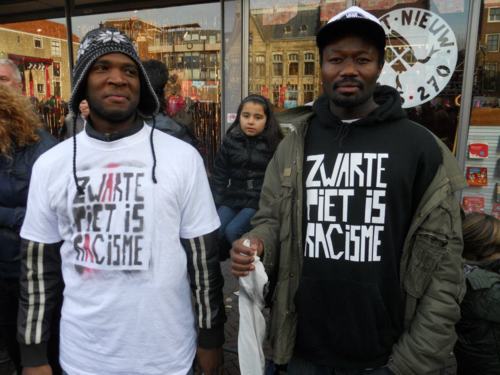
Saint Nicholas and his Servant
Since it’s all over the media, and today in the New York Times, I will briefly enter the fray surrounding the Dutch cultural icon Zwarte Piet (Black Peter).
As many of you know, I am married to a Dutch woman and lived in the Netherlands for about 15 years. My son was born there. It is a small country brimming with creative energy and industrious people. It’s an extraordinary place in countless ways. But with all respect to my Dutch friends and loved ones, let me be blunt.
The problem of Zwarte Piet is not simply that the Dutch can’t understand why outsiders are so upset about the image of a black-faced white person playing the role of Sinterklaas’s servant. Zwarte Piet is, in fact, emblematic of a deeply racist strain within Dutch culture. The reason the Dutch are so upset about foreign criticism of their tradition is because Piet exposes what they pretend does not exist. Something that goes against what they believe about themselves.
When Barak Obama was elected President of the U.S., I believed that it was proof that American society was moving beyond its legacy of slavery and racial inequality–and in some ways that may be true. But the ugliness directed at him since–that he is Kenyan, Muslim, communist etc.–that he is somehow not a legitimate president–all of that exposes the racist undertow running beneath the surface of American society. So, I take care not to single out the Dutch for their Zwarte Piet self-deception.

Not all Dutch people are supporters of Zwarte Piet.
Seven years ago, a short time before I returned to New York with my family, I wrote the following in this journal. I was clearly in something of a funk, but I still stand by it.
It’s getting late in November and the days are growing short, the sun is low in the sky when it does show itself in this mostly dreary climate. It’s almost time for Sinterklaas to arrive on his steamboat from Spain accompanied by his Black Petes. The Dutch cling tenaciously to the iconography of Sinterklaas: the severe bearded man dressed in Catholic bishop’s attire, the black-faced afro-wigged Petes cavorting about. It’s a children’s thing, but it is promoted with what seems an almost manic enthusiasm by adults. To outsiders interlopers like me who cannot get past the racist imagery of Black Pete, the whole business is repellent–and in bad taste. It is cultural heritage as kitsch–not a uniquely Dutch phenomenon, of course–but especially egregious.
Not unique — but especially egregious.
Years ago I would have professed to anyone how Europe was somewhat more advanced when it came to race and cultural relations (with a few notable exceptions, of course). And I would inevitably point to– Yugoslavia as a prime example of how different ethnicities, cultures and religions could live side by side in perfect harmony… Oh, well.
No, they honestly “know not what they do.” Almost as if they’ve lovingly accepted him as one of their own- long as he comes around just once a year, helps out and then leaves just as quickly.
Today’s the day! December 5th.
“Something that goes against what they believe about themselves.”
And by way, I think you’re right about that.
People cling to superficial cultural iconography when they feel threatened by change. The whole “war on Christmas” meme in the US has little to do with Christianity. It’s about reinforcing familiar tradition — and much nonsense — against a perceived tide of multiculturism in which competing signs and symbols coexist. In my view, the Zwarte Piet controversy is no different. But what makes it especially troubling is that such a large majority of Dutch society — so it seems– defends a retrograde symbol with such vehemence.
Happy pakjes avond. No need to change that!